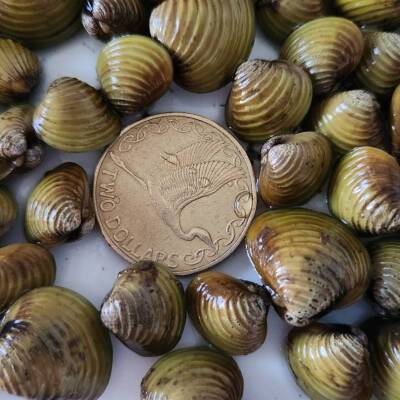
20 October 2023
Safety measures are being ramped up to prevent the spread of destructive gold clams.
In a bid to keep local water pest-free, the Bay of Plenty Regional Council has unveiled an initiative that will allow lake users to scan a QR code at 18 boat ramps in the region in order to fill out self-certification.
It comes amid heightened concern following the discovery of an invasive freshwater gold clam in the Waikato River.
After the discovery, Biosecurity New Zealand closed Lake Ōkataina to boating and fishing throughout October at the start of the fishing season.
The closure, requested by local iwi, was put in place in order to install protections to keep out clams. Surveillance has so far not found the clams anywhere else.
Gold clams, also known as Asian clams, feed on plankton most native species survive on, reproduce rapidly, and can clog infrastructure in the water.
Eradication has never been achieved overseas but efforts have begun to stop the clams from spreading from the Waikato.
Bay of Plenty Regional Council biosecurity aquatic pests officer Te Wakaunua Te Kurapa said self-certification was a requirement to help stop new pests being introduced into and between the Rotorua Te Arawa lakes.
Warranted Te Arawa Lakes Trust biosecurity officers would be at boat ramps over Labour Weekend and throughout summer checking self-certification compliance.
He said previous non-compliance obstacles had been removed with the QR code, and biosecurity officers were able to quickly check the forms online.
The forms could still be filled out on paper, available at the boat ramps, or on the regional council website.
Te Kurapa said new Check, Clean, Dry guidance was developed by Biosecurity New Zealand to ensure that the clam, as well as other invasive freshwater pests, did not spread.
“We’re asking everyone to do their bit to protect the lakes and rivers that we all enjoy and love. Stop the spread of pests before they enter our waterways.”
Biosecurity New Zealand has committed more than $2 million to prevent the spread of the clams.
The money will fund surveillance, scientific advice, suppression trials, and community liaison including iwi capability building, public awareness campaigns and cleaning stations.
Biosecurity NZ readiness and response director John Walsh it was working with iwi, councils and recreational groups to manage the clam and introduce practical measures like boat wash stations.
The first boat wash station was now operational at Lake Karāpiro with more to come, including in the Bay of Plenty.
Biosecurity NZ also launched an awareness campaign appealing to all water users to prevent the spread of the clam.
A Waikato-based coordinator and a team of Check Clean Dry ambassadors had been active since July.
If you think you’ve spotted a gold clam somewhere new, report it on 0800 80 99 66 or by completing the online reporting form at report.mpi.govt.nz. Don’t move it but note the location and provide a close-up photo of the clam as well as one that shows the surroundings.
Before moving between waterways you must do the following for all gear that comes into contact with water:
Check
Remove any plant matter and leave it at the site (the river or lake bank), or put it in the rubbish. Don’t wash it down any drain.
Clean
Dishwashing detergent is not effective against gold clams, but hot water is.
For absorbent material, such as lifejackets or clothing, wash with hot water above 60C for at least 1 minute; between 50-54C (hot household tap water) for at least 5 minutes; or above 45C for at least 20 minutes. Alternatively, soak items in a 10 per cent bleach solution.
Wash down your gear, vehicle, watercraft, and trailer that has been in contact with river or lake water with tap water onto grass, beside the waterway, or at home and not into a stormwater drain system. This will remove any remaining invisible material.
For absorbent surfaces and materials that have been in contact with river or lake water (including carpet on trailers) use an appropriate treatment in the treatment options table on this page.
Treat residual water that always occurs when on-board ballast bladders or tanks have been pumped.
Dry
Ensure gear is completely dry to touch, inside and out, then leave to dry for at least another 48 hours before using it.
Dry areas inside the watercraft where water has pooled with an old towel, and then leave the craft to dry for at least 48 hours.
Source: mpi.govt.nz